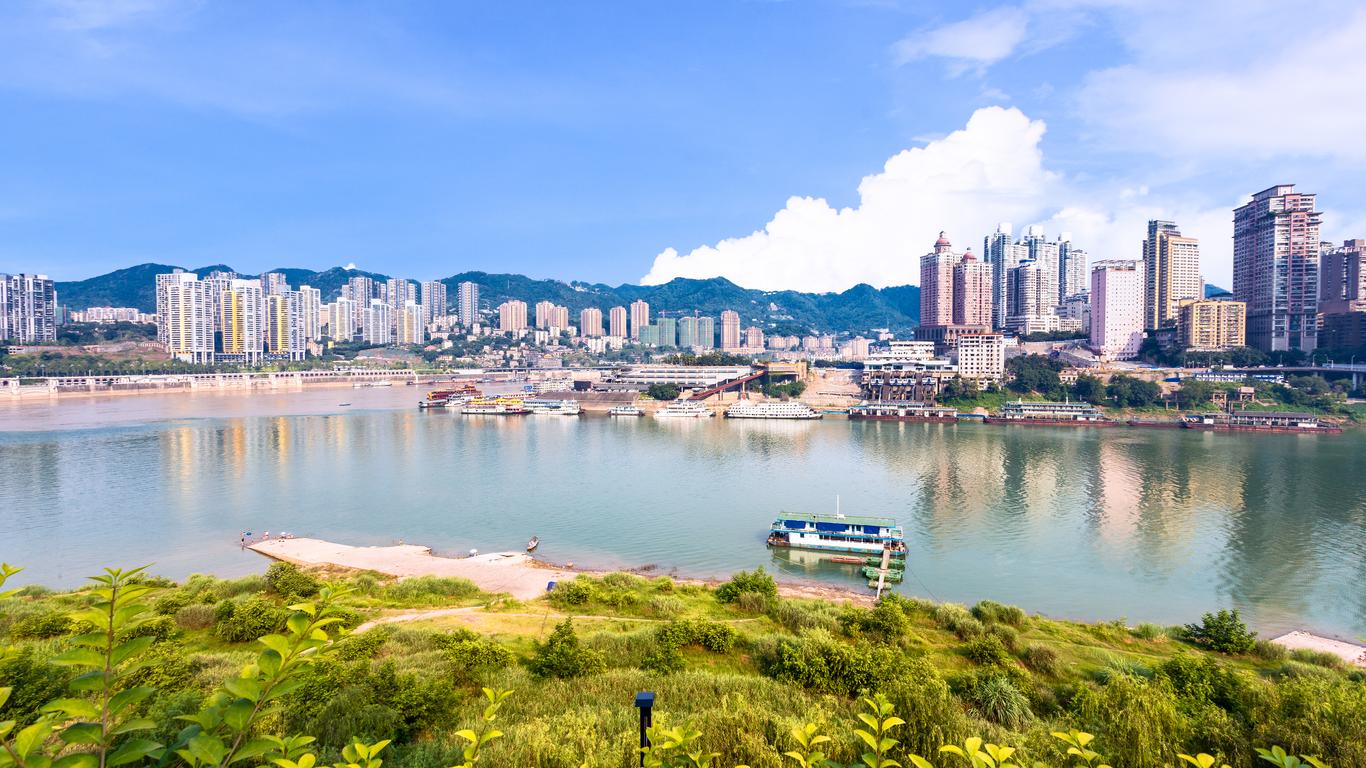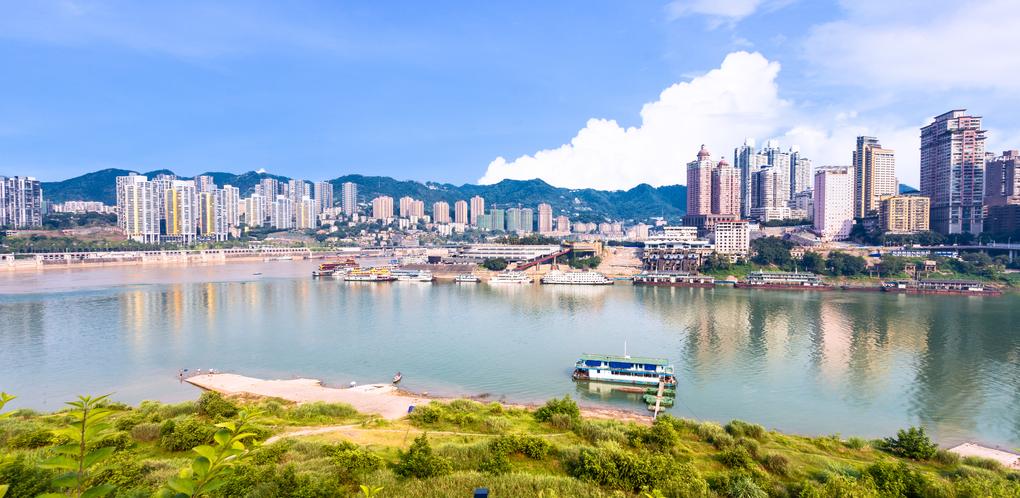
Chongqing travel guide
Chongqing Tourism | Chongqing Guide
You're Going to Love Chongqing
Chongqing is located on the Yungui plateau and surrounded by small mountains. This is the biggest inland city in China and was the capital of the country from the late 1930s to the early 1940s.

Enjoy boat trips down the Yangtze river, learn about Chongqing's past as a porcelain port, and wander through well-preserved old streets, residences, and temples.
Top 5 Reasons to Visit Chongqing
1. Take a Trip Down the Yangtze River
Several cruises depart from Chongqing. Take a boat trip down the river to see some amazing landscapes and to go through the Three Gorges Dam.
2. Visit the Buddhist Dazu Rock Carvings
The UNESCO-listed rock carvings are three hours away from Chongqing.
3. Learn about Modern Chinese History
You can visit the old residence of Zhou Enlai, one of the members of the Communist party, which has been turned into a museum, or head to the old military headquarters of Jiang Jieshi.
4. Explore Ancient History
The Three Gorges Museum houses many artifacts related to the Qing dynasty. You can admire classic architecture and see traditional dancing at the Great Hall of the People.
5. Find Out about the Porcelain Trade
Ciqikou is still an active porcelain port. You will find old streets, small shops, porcelain crafts, and restaurant boats in the area.
What to do in Chongqing
1. An Ancient Community That's Full Of Life
In modern China, ancient neighborhoods like Cíqìkǒu can seem like a miraculous survival, and in many ways that's true. Located a few miles north of Chongqing's city center, this historic suburb dates all the way back to Ming China (1368-1644), and has been lovingly preserved and restored for tourists to enjoy. But it's no theme park. The beauty of Cíqìkǒu is that it's still alive. People live, work and manufacture there. So amid the temples, you'll find thriving porcelain stores and restaurants where the city's famous hotpots are well and truly on the menu.
2. A Homage To Chonqing's American Hero
It might seem odd to find a museum named after an American general in Chongqing, but Joseph W. Stilwell was no ordinary American military man. Stationed in China during World War 2, he helped mastermind the nation's fight against Japan, and did so from his home in Chongqing. Located in the Yuzhong neighborhood, the museum is a great introduction to a remarkable man. Visitors might be especially tickled by Stilwell's prickly relationship with nationalist leader Chiang Kai-Shek - now a pariah figure in modern China. Some say that personal rivalry is why the general remains a cult figure in the area.
3. Simply Gorgeous
A spellbinding geological park, the Wulong Karst is akin to China's version of the Grand Canyon. Formed by the gradual action of the Wu River as it passes through a region of karst limestone, the park is a UNESCO World Heritage Site. But more than that, it's simply stunning. Wonders include the "Three Natural Bridges", which arch across the river, the enormous Furong Cave with its massive "Glory Hall", and Houping Tiankeng - a group of seemingly bottomless sinkholes.
4. A Beautiful Quarter Created By Immigrants
A sprawling complex filled with temples, museums, homes, and shops, Huguang Guild Hall is a joy to explore. Situated next to the Yangtze River, it was once the hub of Chongqing's immigrant community, drawing workers from all over China, which may account for its amazingly diverse architecture. The prayer halls are dazzling, with elegant courtyards and gardens, furnishings, and art works. And at the weekends, the complex becomes a cultural magnet thanks to free performances of Beijing-style opera and singers from Zhejiang province.
5. A Welcome With Genuine Wow Factor
Modern Chongqing's most impressive landmark, the People's Assembly Hall, was built in the 1950s as a kind of palace to impress dignitaries arriving in the city, both from other parts of China and abroad. Stretching over more than 66,000 square meters, it was built in an attractive Ming/Qing revival style, with attention very much focusing on its huge dome, which resembles the Temple of Heaven in Beijing. Heading inside is a must, but it's also fun to explore Renmin Square in the evening, when locals take their daily strolls.
1. An Ancient Community That's Full Of Life
In modern China, ancient neighborhoods like Cíqìkǒu can seem like a miraculous survival, and in many ways that's true. Located a few miles north of Chongqing's city center, this historic suburb dates all the way back to Ming China (1368-1644), and has been lovingly preserved and restored for tourists to enjoy. But it's no theme park. The beauty of Cíqìkǒu is that it's still alive. People live, work and manufacture there. So amid the temples, you'll find thriving porcelain stores and restaurants where the city's famous hotpots are well and truly on the menu.
2. A Homage To Chonqing's American Hero
It might seem odd to find a museum named after an American general in Chongqing, but Joseph W. Stilwell was no ordinary American military man. Stationed in China during World War 2, he helped mastermind the nation's fight against Japan, and did so from his home in Chongqing. Located in the Yuzhong neighborhood, the museum is a great introduction to a remarkable man. Visitors might be especially tickled by Stilwell's prickly relationship with nationalist leader Chiang Kai-Shek - now a pariah figure in modern China. Some say that personal rivalry is why the general remains a cult figure in the area.
3. Simply Gorgeous
A spellbinding geological park, the Wulong Karst is akin to China's version of the Grand Canyon. Formed by the gradual action of the Wu River as it passes through a region of karst limestone, the park is a UNESCO World Heritage Site. But more than that, it's simply stunning. Wonders include the "Three Natural Bridges", which arch across the river, the enormous Furong Cave with its massive "Glory Hall", and Houping Tiankeng - a group of seemingly bottomless sinkholes.
4. A Beautiful Quarter Created By Immigrants
A sprawling complex filled with temples, museums, homes, and shops, Huguang Guild Hall is a joy to explore. Situated next to the Yangtze River, it was once the hub of Chongqing's immigrant community, drawing workers from all over China, which may account for its amazingly diverse architecture. The prayer halls are dazzling, with elegant courtyards and gardens, furnishings, and art works. And at the weekends, the complex becomes a cultural magnet thanks to free performances of Beijing-style opera and singers from Zhejiang province.
5. A Welcome With Genuine Wow Factor
Modern Chongqing's most impressive landmark, the People's Assembly Hall, was built in the 1950s as a kind of palace to impress dignitaries arriving in the city, both from other parts of China and abroad. Stretching over more than 66,000 square meters, it was built in an attractive Ming/Qing revival style, with attention very much focusing on its huge dome, which resembles the Temple of Heaven in Beijing. Heading inside is a must, but it's also fun to explore Renmin Square in the evening, when locals take their daily strolls.
Where to Eat in Chongqing
Eat at Wu MiZhou Hotpot to try the hot pot Chongqing is famous for and to enjoy a breathtaking view of the skyline and the river. If you crave some western food, head to Casablanca. An quick meal should cost you ¥20, mid-range restaurants should cost between ¥30 and ¥60, while an upscale meal might cost ¥100 or more.
When to visit Chongqing
Visiting Chongqing in the summer is not ideal because of the humidity and pollution. Winter months and the early spring can be cold and foggy, making fall the best time for a visit.
How to Get to Chongqing
Plane
The Chongqing Jiangbei International Airport (CKG) is located 13 miles northeast of the city. You can take a shuttle bus, ride line 3 of the subway system, or pay ¥50 for a taxi to get to Chongqing.
Train
There are three major train stations in Chongqing. You can take a train between Chengdu and Chongqing for ¥100 and get from Wuhan to Chongqing for ¥240.
Car
A well-connected and well-maintained network of roads run to the city. Take G5013 to get from Chengdu to Chongqing; G65 if you are coming from Xi'an; and G50 from Wuhan.
Bus
There are many buses from cities like Chengdu, Nanchong, and Yibin to Chongqing. You will arrive at the Chaotianmen station if you are coming from the east, or at the Chen Jiaping station if you are coming from the west.
Airports near Chongqing
Airlines serving Chongqing
Where to stay in Chongqing
Hongyadong - head to this area to see the Chaotianmen harbor, shop at the flea market, and enjoy the atmosphere of an old town.
Popular Neighborhoods in Chongqing
Jiefangbei - this is the perfect area if you want to walk around and shop at a modern mall.
Foreigner Street - home to many foreign-run businesses, this area features plenty of fun attractions such as an Australian bar and an upside-down house.
Where to stay in popular areas of Chongqing
Most booked hotels in Chongqing
How to Get Around Chongqing
Public Transportation
Getting around Chongqing with the subway is very easy thanks to the many lines. Fare is based on distance and should cost between ¥2 and ¥10.
Taxi
Taxi fare starts at ¥10 and you will have to spend another ¥1 per mile.
Car
There are different options for renting a vehicle, including Shenhangzhe Car Rental. Renting a car should cost ¥120 a day.
The Cost of Living in Chongqing
Shopping Streets
You will find plenty of malls in Chongqing, including the Paradise Walk Mall, Metropolitan Plaza Mall, or Xiangquang Times Square.
Groceries and Other
Carrefour and Walmart are located throughout Chongqing as well as many smaller grocery stores. Expect to pay ¥17 for a dozen eggs.
